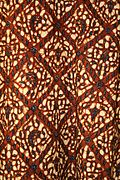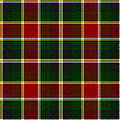- Decatising
-
Decatising or decatizing, also known as crabbing, blowing, and decating, is the process of making permanent a textile finish on a cloth, so that it does not shrink during garment making.[1][2][3] The word comes from the French décatir, which means to remove the cati or finish of the wool. Though used mainly for wool, the term is also applied to processes performed on fabrics of other fibers, such as cotton, linen or polyester. Crabbing and blowing are minor variations on the general process for wool, which is to roll the cloth onto a roller and blow steam through it.
Decatized wool fabric is interleaved with a cotton, polyester/cotton or polyester fabric and rolled up onto a perforated decatizing drum under controlled tension. The fabric is steamed for up to ten minutes and then cooled down by drawing ambient air through the fabric roll. The piece is then reversed and steamed again in order to ensure that an even treatment is achieved.
There are several quite different types of wool decatizing machines including batch decatizing machines, continuous decatizing machines, wet decatising machines and dry decatizing machines.
References
- ^ K. G. Ponting (1972). "Cloth Finishing". In John Geraint Jenkins. The Wool textile industry in Great Britain. Routledge. pp. 170,172. ISBN 0710069790.
- ^ Christopher G. Morris, ed (1992). "decating". Academic Press dictionary of science and technology. Gulf Professional Publishing. pp. 594. ISBN 0122004000.
- ^ K. K. Maitra (2007). "decatising". Encyclopaedic Dictionary of Clothing and Textiles. Mittal Publications. pp. 123. ISBN 8183242057.
Further reading
- J. R. Cooka and B. E. Fleischfressera (1989). "Dimensional Changes Resulting from Pressure-decatizing of Wool Fabric". Journal of the Textile Institute 80 (1): 120–128. doi:10.1080/00405008908659190.
- Trevor Shaw and Max A. White (1984). "The Chemical Technology of Wool Finishing". In Menachem Lewin and Stephen B. Sello. Handbook of Fiber Science and Technology: Part B : Chemical Processing of Fibers and Fabrics, Functional Finishes. 2. CRC Press. pp. 319–320. ISBN 0824771184.
Categories:- Textiles
- Textile arts stubs
Wikimedia Foundation. 2010.



